Hey there, fellow foodies! Ready to embark on a culinary adventure that combines the delicate flavors of fresh fruits with pillowy soft bread? Look no further than the Japanese Fruit Sando!
The delicate sweetness of the fruits matches the filling’s deep creaminess, while the soft bread gives a lovely contrast.
It’s a dessert that pleases not only the palate but also the eyes with its brilliant colors and beautiful appearance.
So, if you’re ready to embark on a journey into Japanese Fruit Sando-making, gather your favorite fruits and some fresh milk bread and stick with Okayreview.
Get your apron on, and let’s begin this delightful journey together!
Table of Contents
What is a Japanese Fruit Sando? How Does It Taste?
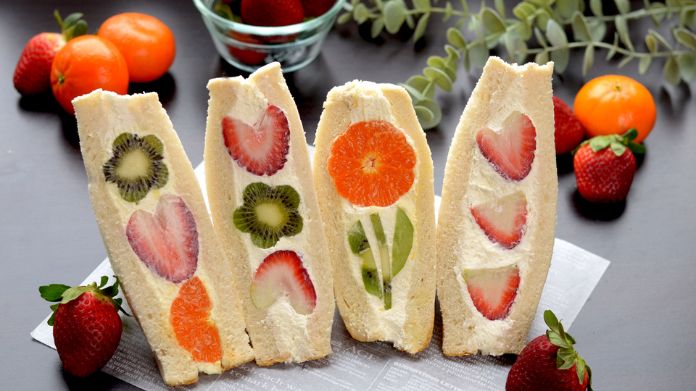 A fruit sando, or Japanese fruit sandwich, is a delectable treat made from two soft pieces of milk bread containing a heavenly combination of whipped cream and fresh fruit.
A fruit sando, or Japanese fruit sandwich, is a delectable treat made from two soft pieces of milk bread containing a heavenly combination of whipped cream and fresh fruit.
The light and airy texture of the whipped cream pairs nicely with the juicy and sweet flavors of fruits like strawberry, kiwi, and pineapple.
Fruit sando is a mix of Japanese and Western culinary ideas based on Japan’s love of ripe fruit and the Western commerce and immigration that brought bread with it.
Fruit sando may be traced back to enterprises such as Yaoiso, a fruit stand in Kyoto founded in 1869, and Sembikiya, a fruit parlor in Tokyo founded in 1868.
Today, fruit sandos have gained popularity worldwide, available in convenience stores in Japan and Japanese grocery stores like Mitsuwa in the US.
What Types of Bread and Fruits Are Used in Japanese Fruit Sando?
1. Bread
Shokupan, commonly known as Japanese milk bread, is required for preparing Japanese fruit sandos.
This fluffy, sweet bread pairs perfectly with airy whipped cream and luscious fruit. While Shokupan may be made at home, it is also sold at Japanese grocery shops and local bakeries.
Shokupan is available in precut or whole loaves, with thicker slices better holding the whipped cream and fruit filling.
If shokunin is unavailable, you can use fluffy white sandwich bread. However, there may be subtle flavor variances. Japanese fruit sandos are a delectable blend of flavors and textures.
2. Fruits
While this type of Japanese sandwich allows for the use of any fresh sweet fruits, there are certain fruits that are commonly preferred, including:
- Strawberries
- Kiwis
- Oranges
- Mangoes
- Blueberries
- Peaches
- Pineapples
- Bananas
- Grapes
How to Make Fruit Japanese Fruit Sando?
To make a delicious Japanese Fruit Sando, follow these simple steps:
1. Gathering the Ingredients
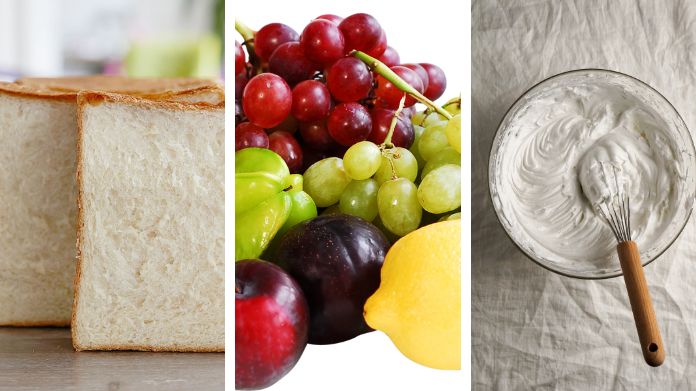 Gather all the ingredients for making Japanese fruit sando, as given below:
Gather all the ingredients for making Japanese fruit sando, as given below:
- Bread
- Whipped cream
- Fruits
2. Making the Whipped Cream
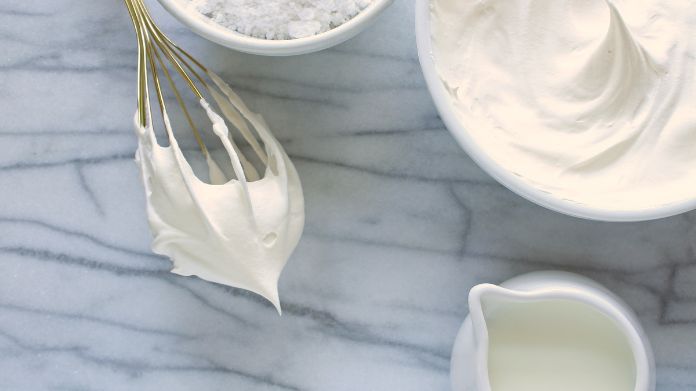 It’s simple to make whipped cream at home! You only need heavy whipping cream, sugar, a bowl, and a whisk (or stand mixer) to start.
It’s simple to make whipped cream at home! You only need heavy whipping cream, sugar, a bowl, and a whisk (or stand mixer) to start.
Add one and a half cups of chilled heavy whipping cream and two teaspoons of sugar in a large mixing bowl.
Whisk the mixture until it thickens and forms strong, shape-holding peaks. Put the whipped cream into a piping bag with a large tip to make it easier.
Refrigerate the whipped cream until ready to build your sandwich for the best results. The freezing step firms the cream even more, which helps to keep the sandwich together perfectly.
3. Preparing the Bread and Fruits
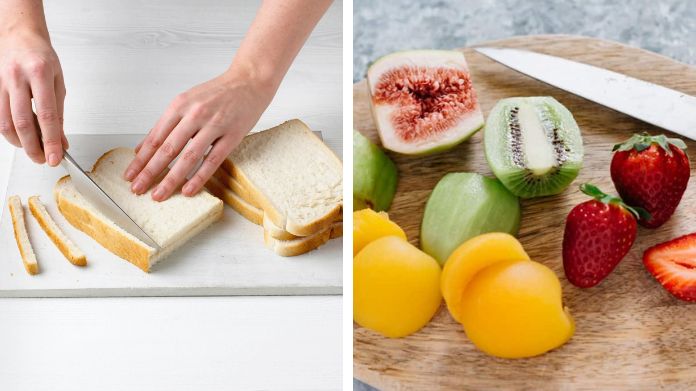 Begin preparing the bread and fruits by removing the crusts from the shokupan to ensure a clean and smooth texture.
Begin preparing the bread and fruits by removing the crusts from the shokupan to ensure a clean and smooth texture.
Moving on to the fruits, peel the kiwi and orange and remove the strawberry stem. Place the fruits on a paper towel to absorb excess moisture and allow them to dry.
This procedure improves the appearance and texture of the fruits, resulting in a beautiful and appetizing experience when presented.
You may improve the quality and attractiveness of your bread and fruit plate by following these easy but necessary measures.
4. Assembling the Sandwich
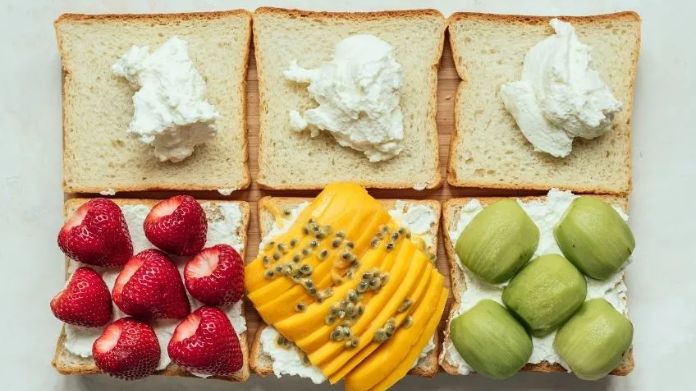 The fun part of creating a delicious fruit sandwich lies in the assembly process. With these quick tips, you can ensure a mouthwatering outcome:
The fun part of creating a delicious fruit sandwich lies in the assembly process. With these quick tips, you can ensure a mouthwatering outcome:
- Preserve the bread’s texture by spreading a thin layer of jam inside each slice. This step prevents the bread from becoming too soggy.
- For an eye-catching presentation, consider the cross-section placement if you plan to cut the sandwich diagonally and showcase heart-shaped strawberries and kiwi circles.
- Arrange the fruit in a diagonal line from the top right corner to the bottom left corner. Ensure the strawberries’ bottoms face the same direction, with their tops touching the bottoms.
- When cutting the sandwich, the kiwis should meet the opposite diagonal direction to create circular cross-sections.
- Utilize a piping bag to fill empty spaces between the fruit, then place another slice of bread on top. Make sure the top piece of bread has jam facing the center of the fruit sandwich.
- Preserve the sandwich’s shape and firmness by covering it with plastic wrap. Mark the top diagonal line you’ll be cutting, and use two plates to press it down gently. This pressing action helps maintain the sandwich’s structure during slicing.
- Use a sharp knife to cut the sandwich diagonally, and remember to wipe it down with a clean towel between each cut. It ensures neat, precise slices for a visually appealing presentation.
By following these steps, you’ll assemble a delicious fruit sandwich that looks impressive. Enjoy the lovely blend of flavors and textures in every bite!
Wrapping Up!!
Making your Japanese fruit sando is a delightful and refreshing experience you can enjoy anytime. Following the easy steps mentioned in this article, you can create a scrumptious dessert to impress your family and friends.
So what are you waiting for? Let’s embark on this fruity adventure together!

